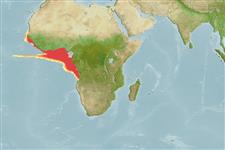>
Beloniformes (Needle fishes) >
Exocoetidae (Flyingfishes)
Etymology: Cheilopogon: Greek, cheilos = lip + Greek, pogon = barbed, beard (Ref. 45335).
Environment: milieu / climate zone / depth range / distribution range
Ecologie
marien; oceanodroom (Ref. 51243); diepte 0 - ? m. Tropical
Eastern Atlantic: Guinea (10°23'N) to Baia dos Tigres, Angola. Not recorded elsewhere. Placed in the genus Cypselurus by some authors.
Grootte / Gewicht / Leeftijd
Maturity: Lm ? range ? - ? cm
Max length : 28.5 cm SL mannelijk / geslacht onbekend; (Ref. 4498)
Found in oceanic or near-shore surface waters. Capable of leaping out of the water and gliding for long distances above the surface.
Levenscyclus en paargedrag
Maturities | Voortplanting | Spawnings | Egg(s) | Fecundities | Larven
Parin, N.V. and R.H. Gibbs Jr., 1990. Exocoetidae. p. 583-591. In J.C. Quero, J.C. Hureau, C. Karrer, A. Post and L. Saldanha (eds.) Check-list of the fishes of the eastern tropical Atlantic (CLOFETA). JNICT, Lisbon; SEI, Paris; and UNESCO, Paris. Vol. 2. (Ref. 4498)
Status op de Rode Lijst van het IUCN (Ref. 130435)
Gevaar voor de mens
Harmless
Gebruik door de mens
Visserij: van minder commercieel belang
Tools
Speciale rapporten
Download XML
Internetbronnen
Estimates based on models
Preferred temperature (Ref.
123201): 25.8 - 27.9, mean 26.6 °C (based on 657 cells).
Fylogenetische diversiteitsindex (Ref.
82804): PD
50 = 0.5000 [Uniqueness, from 0.5 = low to 2.0 = high].
Bayesian length-weight: a=0.00646 (0.00292 - 0.01429), b=3.04 (2.84 - 3.24), in cm total length, based on LWR estimates for this (Sub)family-body shape (Ref.
93245).
Trofisch niveau (Ref.
69278): 3.6 ±0.5 se; based on size and trophs of closest relatives
Weerstandsvermogen (Ref.
120179): Hoog, minimale populatieverdubbelingstijd minder dan 15 maanden (Preliminary K or Fecundity.).
Fishing Vulnerability (Ref.
59153): Low vulnerability (25 of 100).
